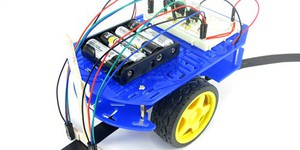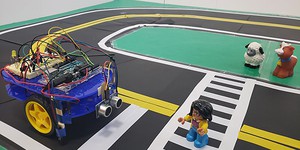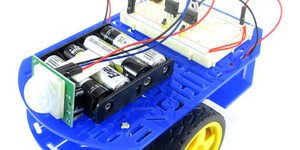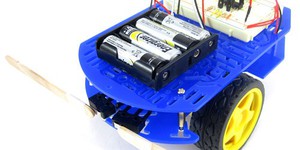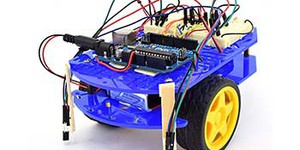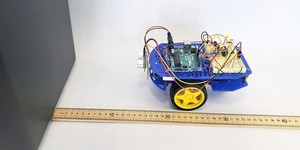How to Assemble Your BlueBot Chassis
Log In
Want to learn more? Check out these other resources:
Lesson Plan
Grade: 6th-8th
Have your students read about autonomous (also called self-driving or driverless) cars in the news? How can you build a car or a robot that will stay on the road without a human driver? In this project, your students will find out by building a robot that can automatically follow a line around a homemade race course, while learning about the electromagnetic spectrum and electronic circuits.
Read more
NGSS Performance Expectations:
- MS-PS4-2. Develop and use a model to describe that waves are reflected, absorbed, or transmitted through various materials.
Lesson Plan
Grade: 8th-12th
2 reviews
This eight-part lesson will guide you through building and programming Arduino-controlled autonomous cars with your students. Each part contains a detailed step-by-step video and a supplemental lesson plan PDF with learning objectives, assessment opportunities, and appendices with circuit diagrams and example code. You can present the material yourself or have students follow along with the videos and pause to work on their autonomous cars.
Read more
NGSS Performance Expectations:
- HS-ETS1-2. Design a solution to a complex real-world problem by breaking it down into smaller, more manageable problems that can be solved through engineering.
Have you ever seen a cat chase a laser pointer or a flashlight beam? What if you could make a robot do that? In this project, you will build a robot that can automatically drive toward a bright light source. The robot uses a simple electronic circuit to track light, so there is no computer programming required! You can also do three other robotics projects using the same kit of parts, so this is a great way to get started with robotics before moving on to more advanced projects.
Read more
How easy is it for you to walk along and follow a line that is painted on the ground? Simple, right? You might be able to follow a line without giving it much thought, but how could a robot do that? In this project, you will build your own automatic line-following robot that can race around a track that you create. This technology has plenty of real-world applications—maybe one day you could help design self-driving cars!
Read more
Do you ever wish you could hire someone to guard your favorite toys, or keep certain people from coming into your room? What if you could make a robot to do it for you? This project will show you how to build a simple security robot controlled by a motion-detecting sensor. When someone comes near your valuables or enters the room, the robot will spring to life and (hopefully) scare them away!
Read more
In the animal kingdom, many different critters use whiskers to help them find their way around in the dark, through murky waters, or even to help them hunt prey. Whiskers can be very useful when the animals cannot rely on sight. Did you know that you can also build a robot that uses "whiskers" to find its way around? This project will show you how to build a simple robot that uses whiskers as "bump sensors" to help the robot detect when it is about to bump into an obstacle, so it can turn…
Read more
Light sensors are part of many devices that we use every day. For example, they help your phone know when to automatically brighten or dim the screen based on ambient light levels. They can also be used to help solar panels track the sun, which helps the panels generate more power. Many spacecraft and planetary rovers are solar-powered. In this project you will build and program your own solar-tracking robot. Optionally, you can add solar panels and rechargeable batteries. Can your robot keep…
Read more
Humans cannot see infrared light, but robots can! At least, they can when they use special infrared light sensors. These sensors can help robots detect nearby objects to avoid collisions and even help them avoid driving off edges. In this project you will build your own Arduino robot that uses infrared sensors to avoid driving off the edge of a table.
Read more
Mechanical switches are common in many machines and robots. They can be used to detect when a button is pushed, when a door is open, or a low-speed collision when two objects bump into each other. Switches can act as "bump sensors" on a simple robot to help it detect when it hits an obstacle. The robot can use this information to navigate around obstacles and avoid getting stuck. Can you build and program a robot that can drive around your house while using bump sensors to avoid obstacles?
Read more
How do self-driving cars stay on the road? How do vehicles with autonomous or driver-assist features automatically brake, steer around obstacles, or perform tasks like adaptive cruise control? Experiment with these behaviors and more in this science project as you build and program your own autonomous Arduino robot.
Read more
How fast can a human driver react and hit the brakes when there is an obstacle in the road? Can autonomous cars react more quickly and make the road safer for everyone? In this project you will build your own Arduino robot and test human braking versus automatic braking as the robot drives toward an obstacle at full speed.
Read more
HELP! Locating survivors trapped under rubble is a difficult and dangerous task. After a natural disaster, like an earthquake, rescuers must act quickly to save as many lives as possible. They can use robots with different types of sensors to help find survivors. In this project you will build a sound-tracking robot that can use two microphones to drive toward a sound source. Designing the robot's algorithm will be up to you.
Read more
Blog Post
Use the BlueBot Robotics kit for a progressive series of robotics engineering and Arduino programming and physical computing projects, from intermediate to advanced.
The BlueBot 4-in-1 Robotics Kit comes with the electronics parts to build four different robots, each with its own sensor-driven behavior. The kit is excellent as a starter kit for students interested in robotics engineering and ready to build circuits on a breadboard, and the first four…
Read more
Explore Our Science Videos
DIY Hand Sanitizer Spray
Model the Planets of the Solar System
Build a Bottle Centrifuge



